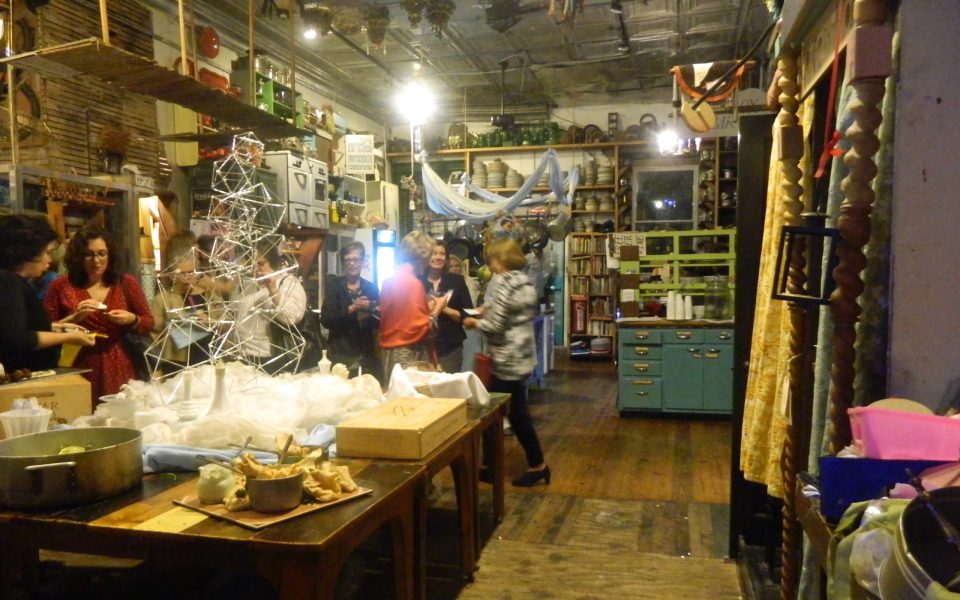1. Elsewhere (GSO)
As President Donald Trump’s new budget calls for the beginning of the end to the National Endowment for the Arts, we point out local institutions that have benefited from the NEA’s largesse, beginning with Elsewhere. The downtown Greensboro thrift store-turned museum is singular in mission and style: It is the artists themselves who rotate through, using the in-house collection to create works for the building and neighborhood. Elsewhere this year received $35,000 in support of its annual work Southern Constellations. Elsewhere has received NEA grants in amounts ranging from $15,000 to $40,000 in 2010 and from 2013 to 2017.
2. RiverRun International Film Festival (W-S)
RiverRun survives through a vast network of donations and small revenue streams that enable it to come to downtown Winston-Salem every spring. They got $10,000 just this year from the NEA to fund Challenge America, a film series at the festival with “corresponding community outreach activities,” according to NEA paperwork. This year’s slate of films is shaping up nicely.
3. Triad Stage (GSO/W-S)
The venerable theater company was not on the NEA’s grant list this year, but last year it was the beneficiary of $20,000 to support a play about the 1960 Woolworth Sit-In. Triad Stage got another $20,000 in 2013 for Radiunt Abundunt, Creative Director Preston Lane’s collaboration with songwriter Laurelyn Dossett, and diminishing amounts for Providence Gap ($15,000, 2010), Bloody Blackbeard ($10,000, 2008), Tobacco Road ($10,000, 2007) and Brother Wolf ($10,000, 2006). They’re at .
4. ArtsGreensboro (GSO)
Arts Greensboro and its predecessor the United Arts Council, charged with bringing some order to the city’s sprawling arts scene, got $20,000 from the NEA last year to help with the Van Dyke Performance Space and $25,000 in 2016 for its own Arts Innovation Grant Program. In 2014, they got $100,000 for the Fabric of Freedom Festival. And none of this includes the funds for the National Folk Festival, almost $1 million per year, that Arts Greensboro helped administer.
5. Arts Council of Winston-Salem & Forsyth County (W-S)
The oldest arts organization of its kind got $200,000 in 2010 for the Creative Corridors project that is just now starting to bear fruit.
6. NC Black Repertory Theatre (W-S)
NC Black Rep got $50,000 in 2011, 2015 and 2017 to help support the biannual Black Theatre Festival in downtown Winston-Salem.
7. UNC School of the Arts (W-S)
UNCSA, the country’s best public conservatory, got two $15,000 grants in 2009, for a dance workshop and a chamber-music festival, and another $40,000 in 2006 for a 50th anniversary production of West Side Story.
8. Reynolda House (W-S)
Between 2007 and 2011, Reynolda House got $123,000 to create a digitized database of its collection.
9. Action Greensboro (GSO)
The young-professionals organization got $100,000 in 2010 to create murals under downtown railroad underpasses and other pieces of public art.
10. Eastern Music Festival (GSO)
Greensboro’s oldest music festival received $10,000 to $15,000 each year from 2009 to 2012 in support of its summer event.
12. North Carolina Theatre Conference (GSO)
The high school theater group got $10,000 in 2017 for its High School Theater Festival.
11. Others
Organizations that have received small grants since 2005 include Piedmont Opera, Green Mountain Chamber Music Festival, Wake Forest University, UNCG and the Greensboro Symphony Orchestra.
Join the First Amendment Society, a membership that goes directly to funding TCB‘s newsroom.
We believe that reporting can save the world.
The TCB First Amendment Society recognizes the vital role of a free, unfettered press with a bundling of local experiences designed to build community, and unique engagements with our newsroom that will help you understand, and shape, local journalism’s critical role in uplifting the people in our cities.
All revenue goes directly into the newsroom as reporters’ salaries and freelance commissions.


Leave a Reply